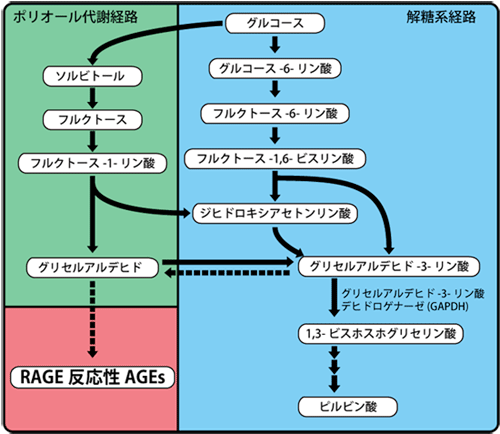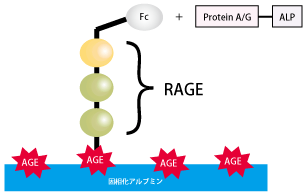Anti-glycation / Aging related
RAGE Reactive AGE Production Inhibition Assay Kit
Screening for components that inhibit the production of RAGE-reactive AGEs
RAGE Reactive AGE Production Inhibition Assay Kit uses recombinant RAGE-Fc to detect AGEs (Glyceraldehyde-AGEs) produced when albumin immobilized on a 96-well plate is saccharified with glyceraldehyde. is. By using this kit, it becomes possible to screen substances that inhibit the formation of glyceralaldehyde-AGEs.
Background
Receptor for AGEs (RAGE) is a type of AGE receptor that is expressed in nerves, kidneys, vascular smooth muscle cells, etc., in addition to monocytes and macrophages.
It has been suggested that RAGE enhances inflammation and oxidative stress when it binds to AGEs, and has attracted attention as a biomarker for age-related diseases that are involved in the production of AGEs in vivo. In addition, among AGEs, RAGE binds with high selectivity to glyceraldehyde-derived AGEs, which are said to be strongly involved in diseases, and its involvement in neurodegenerative diseases such as Alzheimer's disease has been reported in recent years. Therefore, verifying the interaction between RAGE and glyceraldehyde-derived AGEs may provide useful and novel knowledge in elucidating the pathogenesis of disease development mediated by glycation reactions. In recent years, there have been reports that RAGE binds to specific forms of sulfated glycosaminoglycans such as chondroitin sulfate and heparan sulfate on the surface of cancer cells, and is involved in the mechanism of cancer metastasis. tend to.

Fig. 1 Glucose metabolism and formation pathway of RAGE-reactive AGEs
Measuring method

Fig. 2 Detection method for RAGE-binding AGEs
Recombinant RAGE-Fc is used to detect AGEs (Glyceraldehyde-AGEs) produced when albumin immobilized on a 96-well plate is saccharified with glyceraldehyde.
Usage
- Substances that inhibit glyceraldehyde-AGEs formation can be searched using RAGE-FC.
- For the development of anti-glycation materials in the development of functional foods and cosmetics!
Composition
| Albumin-immobilized 96-well plate in | 1 sheet |
| aluminum pouch (8-well x 12 strips) | |
| plate seal | 2 sheets |
| Specimen diluent | 30 mL |
| Glyceraldehyde solution (100 mM) | 5mL |
| Aminoguanidine solution (100 mM) | 500 μL |
| *Anti-glycation standard substance | |
| Wash buffer (x10) | 30 mL |
| blocking buffer | 10 mL |
| RAGE-Fc undiluted solution (x50) | 100 μL |
| ALP-labeled protein A/G stock solution (1000x) | 5 μL |
| Tablet for coloring liquid (for 5 mL) | Three |
| Buffer for preparation of chromogenic solution | 15 mL |
| Diluent for RAGE, ALP labeled protein A/G | 10 mL |
This kit is capable of assaying one 96-well plate.
| Catalog Number | Product Name | Size |
| CSR-AAS-AGE-K04 | RAGE Reactive AGEs Assay Kit, Glyceraldehyde | 1 Kit |
